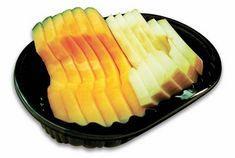
Making an effort to go green usually means cutting back on packaging. Yet increasingly stringent food safety standards demand more detailed information on the contents and provenance of our food.
The challenge for fresh produce suppliers has always been to make their products stand out from the competition. However, with many commercially grown fruits and vegetables indistinguishable from one company to the next, using eye-catching on-pack messaging is one way of getting produce noticed from source to shelves.
Andy Barnetson, director of packaging affairs at the Confederation of Paper Industries (CPI), has been keen to point out how retail corrugated packaging can help growers meet retailers’ expectations.
“Fresh produce suppliers should consider corrugated boxes and casing as useful marketing tools that can provide a colourful backdrop for eye-catching graphics, thanks to the industry’s investment in advanced technology capable of printing up to six colours and the introduction of materials such as clay-coated boards.”
Corrugated packaging has always offered protection without loss of flexibility and this is not likely to change, says Barnetson. “It’s quick to respond to the needs of new, more efficient distribution systems. However, to meet the demand from retailers for easy-to-handle, attractive and environmentally friendly shelf-ready packaging, the innovative use of materials and combinations of components ensures that corrugated can be functional and attractive on shelves, as well as economic and hygienic.”
A recent survey by CPI found that corrugated packaging is leading the way in optimising the appearance and performance of product ranges.
CPI, which represents 90 per cent of the corrugated packaging industry, commissioned a poll of predominately food and beverage manufacturing companies. It revealed that corrugated cardboard is rated first choice packaging material by 79 per cent of the 100 businesses contacted.
Some 80 per cent of respondents thought corrugated is either ‘very important’ or ‘critical’ to the future of their business and 83 per cent agreed with the statement that ‘corrugated retail-ready packaging helps promote products or brands in store’.
These figures underline that the UK corrugated industry is at the forefront of innovation and high quality,
according to Barnetson. He points out that in addition to innovative branding, environmental concerns are also impacting on the fresh produce industry. “With initiatives to reduce packaging waste and packaging weight to the fore, producers are under pressure to adopt packaging methods to meet the needs of retailers. And they are also under pressure to maximise profits as they cope with increased costs.”
With that in mind, it is worth noting that the corrugated industry uses and promotes a sustainable and renewable material, over 80 per cent of which is recycled, saving an area the size of Greater London from landfill every four months.
In addition, during the last decade the industry has initiated weight savings without impairing protective or structural qualities, and the drive for even greater efficiencies continues. Advances in material science are also leading to new types of structural products such as corrugated pallets, which offer huge economic and other advantages.
Companies are constantly exploring ways to improve the effectiveness and efficiency of their traditional packaging solutions, by looking at new grades of paper and surface treatments, while at the same time turning to corrugated to extend its range.
“Meeting retailers’ expectations requires quality pre-printing and better packaging design for space efficiency; in effect, a packaging solution that meets the needs of the entire supply chain, rather than just the production of a brown corrugated packaging box,” explains Barnetson. “Packaging in the fresh produce sector is changing and producers need to be ready to adapt quickly. Patriotic packaging themes can help sell goods in 2012 but reduced pack weights and recycled materials are also becoming essential in helping producers respond to what the retailers want.”
Elsewhere manufacturers are looking for new ways to stamp their environmental credentials on pack. Smurfit Kappa, for instance, has become the first packager to be awarded the Carbon Trust standard.
“A lot of investment has gone into developing our eco credentials,” explains Paul Christmas, sales development manager of Smurfit Kappa Lokfast.
The company has spent £98 million upgrading its paper mill in Kent to be able to run lightweight material. “All our products are paper-based and made from recycled paper,” he explains.
It all goes to highlight how seriously manufacturers are taking their environmental responsibilities, and that spreads right across the spectrum, regardless of what materials are being used.
Linpac director of innovation Alan Davey, speaking at the recent European Plastics and Composites Innovation Days, organised by the European Plastic Converters Association, said: “We have a very good case to make for plastics and plastics packaging, but as an industry we are punching below our weight and need to work harder to show retailers and consumers the benefits of packaging for preserving and storing food at a time when food waste is one of the biggest environmental issues facing Europe.
“We need to address the challenges facing the industry including the changing needs of the market; the effectiveness of packaging; the need to drive down food waste and deliver environmental benefits.” -
THE PRICE IS NOT RIGHT
Polystyrene is one of the most widely used plastics. It is a polymer made from styrene, which itself is manufactured from crude oil. Styrene prices in Europe have risen by 10 per cent since February 2012 and are up by 15 per cent year-on-year. Crude oil, meanwhile, is up by 10 per cent and 23 per cent in euro terms over the same period.